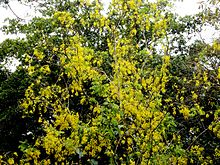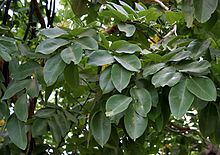Description[edit]
The golden shower tree is a medium-sized tree, growing to 10–20 m (33–66 ft) tall with fast growth. The leavesare deciduous, 15–60 cm (5.9–23.6 in) long, and pinnate with three to eight pairs of leaflets, each leaflet 7–21 cm (2.8–8.3 in) long and 4–9 cm (1.6–3.5 in) broad. The flowers are produced in pendulous racemes 20–40 cm (7.9–15.7 in) long, each flower 4–7 cm (1.6–2.8 in) diameter with five yellow petals of equal size and shape. The fruit is a legume, 30–60 cm (12–24 in) long and 1.5–2.5 centimetres (0.59–0.98 in) broad, with a pungent odor and containing several seeds. The tree has strong and very durable wood, and has been used to construct "Ahala Kanuwa", a place at Adams Peak, Sri Lanka, which is made of Cassia fistula (ahala, ehela, oraehaela, ඇහැල in Sinhala [2]) heartwood.
Cultivation[edit]
Cassia fistula is widely grown as an ornamental plant in tropical and subtropical areas. It blooms in late spring. Flowering is profuse, with trees being covered with yellow flowers, many times with almost no leaf being seen. It will grow well in dry climates. Growth for this tree is best in full sun on well-drained soil; it is relatively drought-tolerant and slightly salt-tolerant. It will tolerate light brief frost, but can get damaged if the cold persists. It can be subject to mildew or leaf spot, especially during the second half of the growing season. The tree will bloom better where there is pronounced difference between summer and winter temperatures.[3]
Pollinators and seed dispersal[edit]
Various species of bees and butterflies are known to be pollinators of Cassia fistula flowers, especially carpenter bees (Xylocopa sp.).[4] In 1911,Robert Scott Troup conducted an experiment to determine how the seeds of C. fistula are dispersed. He found that golden jackals feed on the fruits and help in seed dispersal.[5]
Medical use[edit]
In Ayurvedic medicine, the golden shower tree is known as aragvadha, meaning "disease killer". The fruit pulp is considered a purgative,[6][7] and self-medication or any use without medical supervision is strongly advised against in Ayurvedic texts. Though it has been used in herbalism for millennia, little research has been conducted in modern times.
Culture[edit]
The golden shower tree is the state flower of Kerala in India. The flowers are of ritual importance in the Vishufestival of Kerala, and the tree was depicted on a 20-rupees stamp. The golden rain tree is the national flowerof Thailand; its yellow flowers symbolize Thai royalty. A 2006–2007 flower festival, the Royal Flora Ratchaphruek, was named after the tree, which is known in Thai as Ratchaphruek (Thai: ราชพฤกษ์) and the blossoms commonly referred to as dok khuen (Thai: ดอกคูน). C. fistula is also featured on a 2003 jointCanadian-Thai design for a 48-cent stamp, part of a series featuring national emblems.[3] Cassia acutifolia, the pudding-pipe tree, furnishes the cassia pods of commerce.







No comments:
Post a Comment